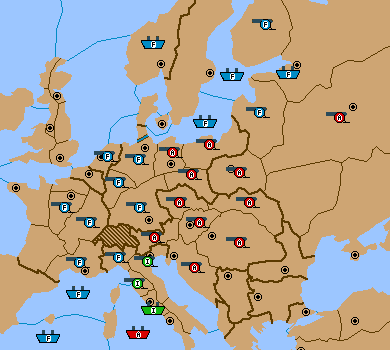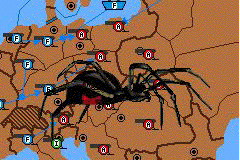



Jamie Dreier
Myself, I was looking forward to Dan Shoham's column. Then I discovered that it would consist of a selection of his EOG statements. Disappointing. I'd been hoping that he'd give some lessons. What's worse, Dan has disappeared, so even the EOG statements are not to be expected for near-future issues of The Diplomatic Pouch. So, I says to myself, "Stop whining and do something about it." Here's what I decided to do about it.
Diplomacy players are full of advice (among other things). But not a whole lot of it is terribly useful. Not very much Diplomacy advice generalizes to principles that you can use in games. What little there is has been assimilated by most reasonably advanced players, say, those who designate themselves Experts (and some who too modestly register as Intermediates).
Herewith, a bit of endgame analysis that does generalize, and is useful. It is intended for experienced players who are looking to add another arrow to their quiver. I've somewhat whimsically called this a "Master Class," and I'll be pretending (?) that readers are eager analogues of what the chess world calls "candidate masters." From time to time, I ask you to stop reading and consider one or another aspect of the situation I describe, asking you to solve a certain problem or just answer a little question. I think it's worth working through the article this way.
As a prelude....
Sometimes, occasionally, rarely, you may reach a position from which you have a forced win. Now, a strict forced win is a position from which you will certainly win with a particular set of moves, even if everyone else guesses right every time. Even if the other players could actually see your moves before they entered theirs, you'd still win. Such positions are rare, and they are fairly easy to spot when they arise. I am interested (both in practice and in a theoretical way) in a "virtual force." This article explains virtual forcing by an example. It's rather too complicated to explain in this prelude. So, on with the Master Class.
Here is a position that arose in actual play. In fact, I will give only half of the position, and some stipulations about the rest. The stipulations are not thoroughly realistic -- in the actual game, the position southwest of Switzerland was somewhat more complicated. For the purposes of this "class," I have to strike a balance. I do want to stress the realism of the situation; this isn't a pure exercise in logic, but a crucial part of endgame tactics. On the other hand, for this lesson I want a position that has what I call a "virtual force." Generally, in a real game there will be some unforced elements. I am trying to isolate the forced elements. In the game from which this position was taken, there were some chancy, unforced elements southwest of Switzerland. Combining forced elements with probabilistic considerations is for another class (preferably one conducted by someone else).
The position:
AUSTRIA: A Tyrolia, A Bohemia, A Berlin, A Silesia, A Prussia, A Moscow, A Warsaw, A Trieste, A Vienna, A Budapest, A Galicia.
FRANCE: A Munich, A Kiel, A Ruhr, A Burgundy, A Piedmont, A Marseilles, F Gulf of Lyon, A Livonia, F St. Pete(sc), A Fin, F Norway, F Gulf of Bothnia, F Baltic, F North Sea, A Holland, A Paris.

Further features of the positon: Italy and Austria are allied in trying to prevent France from winning the game. France has captured Tunis, and is in position to hold it come what may. (Since this is a Master Class, I don't need to explain how this is possible!) There is no chance of penetration in either direction in the Mediterranean. The sole channel of intercourse between the two sides south of Switzerland, is the Piedmont-Tyrolia connection. We shall stipulate that Italy and Austria are unable to drive the French Army Tyrolia out of there.
France and Austria have as many units as they need. The relevant part of the board is full, with all spaces occupied.
France now owns 17 supply centers. (Again, all Candidate Masters will be able to see which centers those are.) She has only one chance at an 18th center: Berlin. Only one of her centers is even marginally at risk, given any moderately realistic move: Munich. France's object is to capture Berlin while retaining Munich. The Allies aim to hold on to Berlin, or capture Munich, and set up a position from which France can advance no further. (This is not a further stipulation. It follows from the position and the prior stipulation about the Mediterranean. Once more, all Candidate Masters may easily verify this fact.)
In short, France has to take Berlin without losing Munich, or take Berlin while losing Munich but then recapture Munich without losing Berlin, or the like. Austria/Italy have to somehow seal up the position in Germany so that Austria permanently holds Munich or Berlin (or both!), or possession of Berlin and Munich alternate ad infinitum. Since Italy's moves play no role in the forthcoming analysis, I will call the southeast alliance "Austria" from now on.
 Before reading on, look over the position, and
consider what
plausible sets of orders each side has. Note the French army in Livonia,
and the one in
Piedmont. What are their roles? Consider Austria's defensive possibilities.
Does he have
offensive chances at all? Under what circumstances?
Click here when your pencil is back on your desk.
Before reading on, look over the position, and
consider what
plausible sets of orders each side has. Note the French army in Livonia,
and the one in
Piedmont. What are their roles? Consider Austria's defensive possibilities.
Does he have
offensive chances at all? Under what circumstances?
Click here when your pencil is back on your desk.

